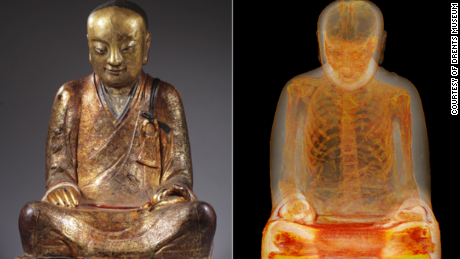Jack Omnitrade's Original Blog
China claims that the Buddha statue, exhibited at the Hungarian Natural History Museum, was stolen from Fujian Province. This statue was a phenomenon because a 1,000-year-old mummified monk was found encased in it. The China Daily reported on 24 March 2015 that China's State Administration of Cultural Heritage had taken the necessary steps to retrieve the statue.
The mummified monk statue is now in the possession of a Dutch collector. The mummified monk statue made its debut when it first showcased at Drents Museum in the Netherlands last year. The mummy was discovered when a collector brought it to an expert for restoration. Subsequently a team of researchers and scientists was brought in to do a comprehensive study. CT scan show the mummy sitting on a bundle of cloth covered in Chinese inscriptions, revealing its identity as a Buddhist monk called Liuquan, the CNN reported on 23 March 2015.

China's Claim
According to the documents, the monk was a local man who gained a reputation for curing diseases and promoting Buddhist principles. He passed away at the age of 37. Pictures provided by the Da Tian Museum, Fujian and those taken during the exhibition were found to have identical facial expressions as well as scratches on the stomach and the hand. The shape, height and weight of the Dutch collector's statue matches the measurements provided by the Da Tian Museum. The same Chinese character is also carved on the cushion that the Buddha sits on. "There are five proofs of evidence that show that the Buddha statue is the relic stolen in 1995 from a Chinese ancestral temple in Fujian province's Yangchun village," said a spokesman of the Da Tian Museum in Fujian.
The Dutch Collector's Claim
On March 23, the Dutch collector issued a statement saying the statue was acquired in 1994 from a sincere Chinese friend in the art circles. The statue was shipped to his residence in Amsterdam from a workshop in Hong Kong in 1995. Coincidentally, a Buddha relic was reported stolen in China in 1995. The Chinese and Dutch governments will seek a diplomatic solution to address the issue.
My Comments
CNN claims that, "It's unclear exactly when or how the statue made its way to a market in the Netherlands where a private buyer bought it in 1996." I think tracking how the statue left China would be as exciting. Looking for trails on how it get to Hong Kong from China should be the starting points for the Chinese cops. Back in 1996, they had no clue where to start when it was reported missing. Now they should have information on who the Dutch collector brought it from.
No comments:
Post a Comment